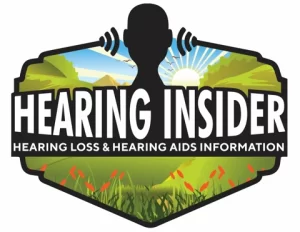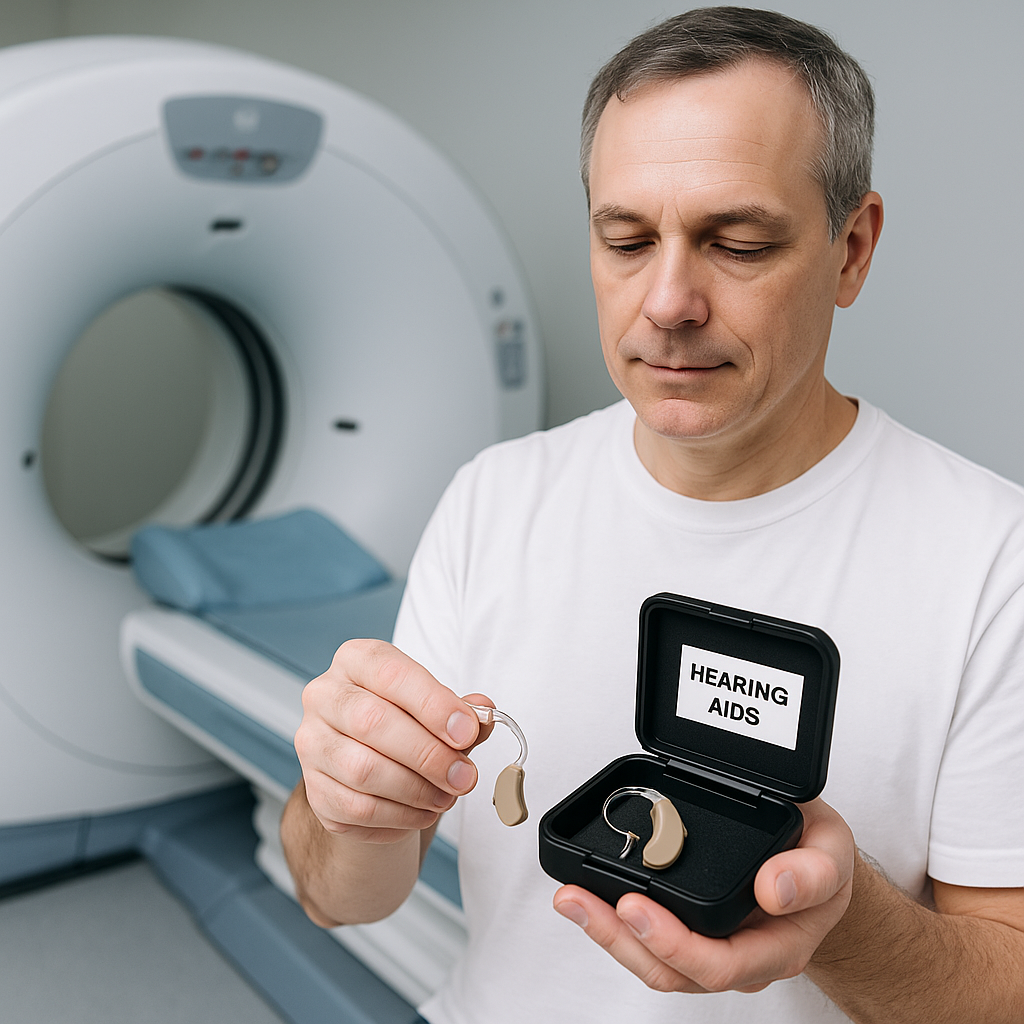Wearing hearing aids improves everyday communication, but certain medical procedures can pose risks to your devices or affect test accuracy. Use this clinician-written guide to know when to remove hearing aids—and when it’s usually safe to keep them in.
Quick tip on loss prevention: Hospitals frequently misplace hearing aids. Keep them in a labeled protective case and store with your personal belongings rather than handing them to staff.
🧲 MRI Scans: Remove Your Hearing Aids
Key takeaway: Always remove hearing aids before an MRI. MRI machines use strong magnetic fields. Because hearing aids contain metal and electronics, they can heat up, distort images, or be damaged. Tell the technologist in advance, and store devices outside the MRI room in a labeled case. Learn more about MRIs from the American Cancer Society.
📸 X-Rays: Usually Safe, But Check
Key takeaway: You can usually leave hearing aids in for X-rays, especially if the scan isn’t focused on the head or ears. For dental or head/neck X-rays, you may be asked to remove them to avoid image artifacts and accidental damage.
🌀 CT Scans: Case-Dependent
Key takeaway: Consult the radiology team. Remove devices for CT scans of the head/ears to prevent image obstruction; body scans often allow devices to stay in. Bring a hearing aid case in case removal is needed. See also the NCI overview.
☢️ Radiation Therapy (Cancer Treatments): Remove in the Treatment Room
Key takeaway: Remove hearing aids before entering the treatment room for external beam radiation therapy. High-dose radiation near the head can damage electronics and certain plastics. Many centers allow devices during setup only for communication; hand them to a caregiver before treatment begins.
🦷 Dental Procedures: Precautions for Drills & Ultrasonic Scalers
Key takeaway: You can usually wear hearing aids at the dentist, but consider turning them down or to mute during drilling or ultrasonic cleaning to avoid discomfort and feedback. For long appointments, consider bringing a battery/charger and ask the team to face you and speak clearly when devices are out.
🛌 Surgeries & Electrocautery: Remove Unless Your Team Says Otherwise
Key takeaway: Remove hearing aids before anesthesia. Electrocautery and monitoring equipment can introduce electromagnetic noise; devices can be lost or damaged during transfers or intubation. Tell staff you wear hearing aids so they can optimize communication pre/post-op. Related: When to wear hearing aids.
🧠 EEG (Electroencephalogram): Remove for Accurate Readings
Key takeaway: Remove hearing aids for EEGs. Devices can interfere with electrode placement around the ears and introduce artifacts.
🔊 Ultrasound & ENT Ultrasonic Tools: Generally Fine, With Exceptions
Key takeaway: Diagnostic ultrasounds away from the head are typically fine with hearing aids in place. For ENT procedures using ultrasonic tools close to the ear, you may be asked to remove devices to avoid vibration/feedback.
✅ Generally Safe Tests (Often OK to Keep Devices In)
- ECG/EKG (heart monitoring)
- Spirometry and basic pulmonary function testing
- Blood draws and vital signs
If straps, masks, or ear clips contact the ear, remove your devices temporarily to prevent dislodging. See also: confidence tips for hearing aid users
🫧 Hyperbaric Oxygen Therapy: No Electronics Allowed
Key takeaway: Do not wear hearing aids in a hyperbaric chamber. These oxygen-rich, pressurized environments are highly flammable; electronics and batteries are prohibited.
📝 Summary Table: Hearing Aid Guidelines by Procedure
| Procedure Type | Remove Hearing Aids? | Notes |
|---|---|---|
| MRI | ✅ Yes | Strong magnets; risk of heating, damage, and artifacts |
| X-ray | ❌ Usually No | Remove for head/neck/jaw imaging |
| CT scan | ⚠️ It Depends | Remove for head/ear scans; okay for distant body areas |
| Radiation therapy | ✅ Yes (in room) | Setup only with devices; store before treatment |
| Dental procedures | ⚠️ Maybe | Mute or remove during drilling/ultrasonic cleaning |
| Surgery & electrocautery | ✅ Yes | Remove prior to anesthesia to avoid interference/loss |
| EEG | ✅ Yes | Interferes with electrode placement and signals |
| Ultrasound (diagnostic) | ❌ Usually No | Remove for ENT ultrasonic tools near ear if requested |
| ECG/EKG, spirometry, blood draws | ❌ Usually No | Remove if straps/masks disturb devices |
| Hyperbaric chamber | ✅ Yes | No electronics allowed due to fire risk |
Knowing when to keep your devices in—or take them out—during medical procedures is key to safety and comfort. For more practical advice on everyday hearing aid use, explore our Living with Hearing Aids guide.
❓ Frequently Asked Questions (FAQs)
1) Can I wear hearing aids during an MRI?
No. Remove them before the scan to prevent heating, damage, or image distortion.
2) Will X-rays damage my hearing aids?
Usually no, but remove them for head/neck/jaw X-rays.
3) Are CT scans safe for hearing aids?
Often, but remove them for head-focused scans. Bring a case.
4) Should I wear hearing aids during surgery?
Generally remove prior to anesthesia; follow your surgical team’s instructions.
5) Can I keep hearing aids in at the dentist?
Yes, but lower volume or mute during drilling or ultrasonic cleaning.
6) Why not in a hyperbaric chamber?
Electronics and batteries pose safety risks in oxygen-rich environments.
7) What about radiation therapy?
Remove devices before entering the treatment room; use them only during setup if permitted, then store safely.
8) Do hearing aids interfere with EEG tests?
Yes—remove to allow proper electrode placement and clean signals.

